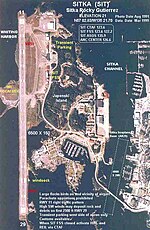Mt. Edgecumbe High School (abbreviated MEHS) is a public boarding high school in Sitka, Alaska in the United States. Located on Japonski Island, across Sitka Harbor from the northwestern corner of downtown Sitka, the school is situated on a portion of Sitka's former World War II-era military installations. Established in 1947 after the military abandoned the area, the school was originally operated by the federal Bureau of Indian Affairs (BIA) as part of a network of boarding high schools, which included schools in Eklutna and Wrangell. After several decades of operation by the BIA, the school was briefly closed in the 1980s before being reopened by the Alaska Department of Education, which operates it today.
For administrative and statistical purposes, MEHS is considered by the state to be a school district, albeit one consisting of only one school. The enrollment was 421 students as of October 1, 2014. The student body, both in its former and current incarnations, is predominately from rural Alaska. For a time, until the resolution of the Tobeluk v. Lind lawsuit and the subsequent construction of K–12 schools in most rural communities, MEHS was one of the few viable options many rural students had to obtain a high school education, as BIA schools in rural villages only provided schooling until the eighth grade. Today, the school still attracts rural residents, primarily students from communities too small to qualify for state school funding, plus exceptional athletes who seek to develop their skills beyond what competition their local school districts can provide.
The school is named for Mount Edgecumbe which is located on Kruzof Island, a 3,077 feet (938 m) high dormant volcano visible from the campus. The mountain, in turn, was named for George, Earl of Edgecumbe, by British Captain James Cook in 1778. Outside of the school year, the campus has hosted summer camps such as the Sitka Fine Arts Camp, which is now located on the campus of the defunct Sheldon Jackson College, as well as a portion of the inaugural Outer Coast College Summer Seminar in 2018.








